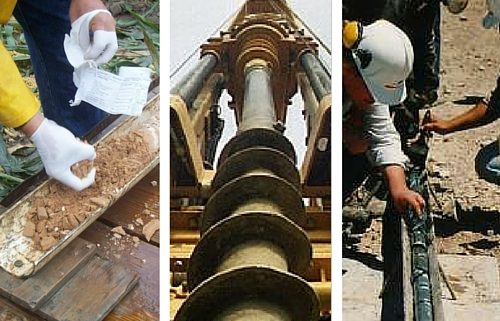Soil Testing – Not all Soils are Safe for Construction
 We’ve all heard about the importance of building a foundation on solid ground. But what constitutes “solid” and how do you find out if soil is suitable for a construction project? Soil needs to resist the weight of the building. If it doesn’t resist the weight of the building, the building moves.
We’ve all heard about the importance of building a foundation on solid ground. But what constitutes “solid” and how do you find out if soil is suitable for a construction project? Soil needs to resist the weight of the building. If it doesn’t resist the weight of the building, the building moves.
It’s important to calculate the weight of the building
and test the soil to see if it can support the weight.
Soil Testing
Whether you are building a house addition or a new school, a soil test is required. Soil testing provides important clues about the soil’s bearing capacity, density, compaction, presence of organic matter, sand, and contaminants.
Geotechnical engineers take samples of soil using specialized equipment, based on the architect’s drawing of soil coring locations. These samples are analyzed in a lab for their characteristics including compressive and shear strength, moisture content, soil index, density, permeability, consolidation, and foundation load. A soils report is generated, along with suggestions about the best foundation type for the new building project. The report is based on their test results and the principles of the ASTM (American Society for Testing and Materials).
Using this preliminary information, the architect finalizes their foundation design documents. Now it’s time to start digging!
Soil Excavation
Soil samples taken by geotechnical engineers are just that – samples from which we can make an educated guess. We really don’t know the content of the soil in the foundation area until the contractor excavates.
Once the bulldozers move in, the excavation exposes the bearing soil and deficient areas are sometimes revealed. Non-bearing soil, such as tree roots, peat, or debris may become exposed. These are not suitable to support a building. In this case, the architect will suggest remedial action.
Replacing Organic and Other Poor Soils
There are many types of soil but not all are suitable for supporting a building. Some soils, like clay, are great at supporting a building foundation because they are mostly inorganic and don’t move readily. Soils that are full of organic matter will decompose over time and move, so they are not suitable for supporting a foundation. Other soils like unconfined sand have poor bearing capacity because the grains have lots of space between them and they may shift with time. If soils are found to be inappropriate to support the building, they have to be removed before the foundation is built.
Organic soils are not structurally sound and
cannot be used to support buildings.
Sometimes the existing soil needs to be removed because it is contaminated, which could be harmful to people. For instance, old gas stations often have deteriorating underground gasoline tanks. The gasoline leaks out and contaminates the soil and groundwater over time. In these cases, careful removal and disposal of contaminated soils is necessary. This process is regulated by the EPA and local authorities.
Sometimes we just need to remove organic matter and replace it with an inorganic substitute that is more stable, like gravel. Once the unsuitable soil is replaced with load bearing soil, the foundation can be built.
Building the Foundation
Have you ever noticed that it seems to take forever to build a foundation? But once the foundation is in place, the superstructure seems to be built overnight! Why is this?
- The soil needs to be evaluated for suitability to support the building.
- Suitable fill needs to be brought in to replace unsuitable or organic soil.
- The foundation needs to be built in the right size and shape. Any mistakes in the foundation will impact the structure above.
Thinking about starting a building project? Give us a call; we have extensive experience in evaluating the suitability of proposed sites for building development. We provide value to our clients through our practical use and understanding of soil testing, including the factors that can come into play based on testing results. For more information on soil testing, check out this interesting website: http://www.constructionknowledge.net/sitework/sitework_soils_and_geology.php



